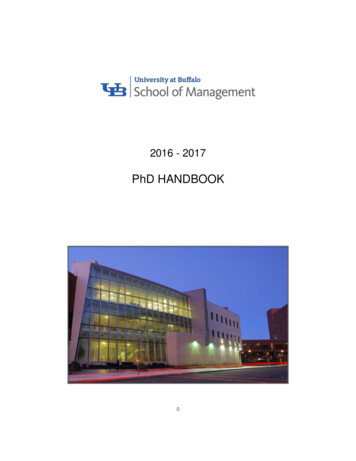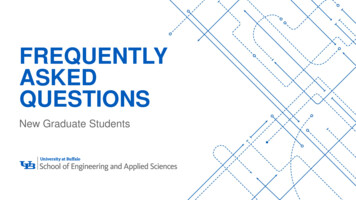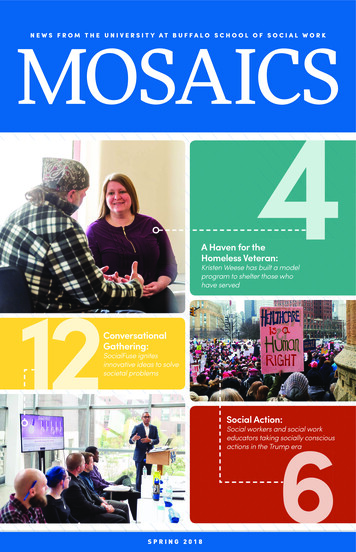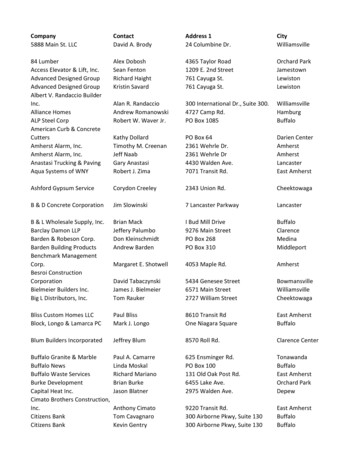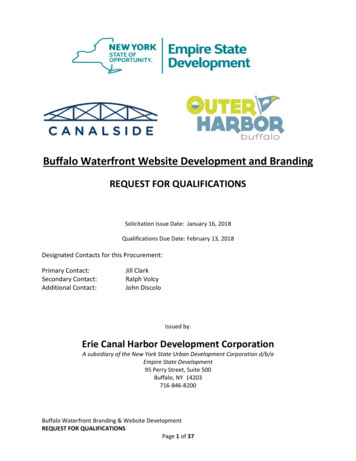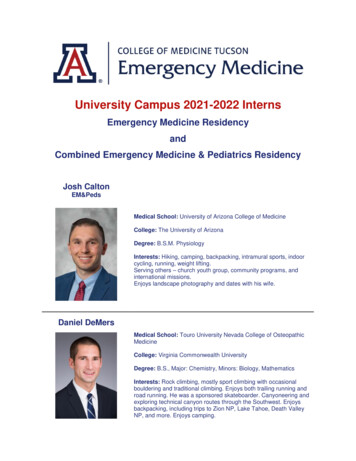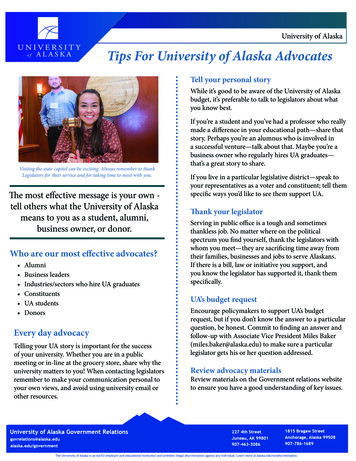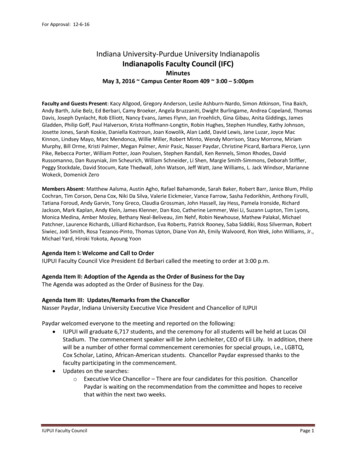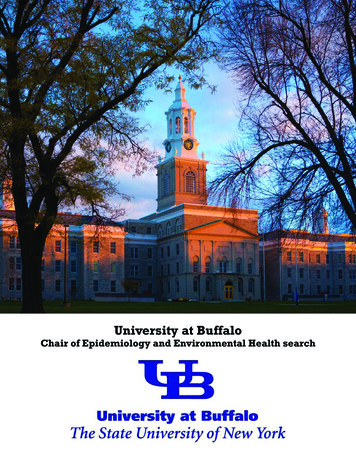
Transcription
University at BuffaloChair of Epidemiology and Environmental Health search
AboutUniversity at Buffalowww.buffalo.eduA flagship institution in theState University of New Yorksystem, the University atBuffalo (UB) is the largest, mostcomprehensive campus in the64-campus SUNY system and aninternationally renowned centerfor academic excellence. Impactfulresearch, scholarly distinction,transformative student experiences,and far-reaching service to local,state, national, and internationalcommunities define UB’s missionas a premier research-intensivepublic university. UB was foundedin 1846 as a private medical collegelocated in downtown Buffalo andjoined SUNY in 1962. In 1990,UB was the first public universityin the Northeast to be admittedinto the Association of AmericanUniversities (AAU), joining NorthAmerica’s other leading researchuniversities.UB enrolls close to 30,000students (approximately 2/3undergraduate and 1/3 graduateand professional students) andoffers nearly 400 degree programsat the baccalaureate, master’s,professional and doctoral levelsacross its 12 decanal units. UB isa global community of scholarsconsistently ranking among thenation’s top 20 universities forthe enrollment of internationalstudents. The university enjoysa strong international presence,maintaining affiliation agreementswith over 80 universities in Asia,Europe, Latin America, and Africa.UB’s approximately 240,000 alumnilive in over 145 nations worldwide.UB has a distinguished facultyof approximately 1,600 full-timemembers and almost 750 part timemembers. With more than 150research centers and institutes,UB’s current annual researchexpenditures, including affiliatedinstitutions, exceed 386 million.The Libraries hold four millionvolumes in eight libraries andprovide access to 100,000 full-text ejournals and 800,000 e-books.Recognizing the key role thata vibrant 21st century physicalcampus environment plays inenhancing education, research, andlearning as part of the UB 2020vision, UB is implementing a longrange plan for enhancing its North,South, and Downtown campusspaces and connecting them moreeffectively to their surrounding-2-communities. UB’s North Campus,located in the Buffalo suburb ofAmherst, is the university’s mainundergraduate campus, and hometo the university’s primary athleticsand cultural facilities. Three milesto the south, on the northernedge of the City of Buffalo, is theuniversity’s historic South Campus,which serves as the primary healthsciences campus. UB also has arapidly developing third campuscenter in downtown Buffalo. Thefocal point of UB’s downtownpresence is the Buffalo NiagaraMedical Campus, on which UB’snew medical school facility wasopened in the fall of 2017.With annual revenues that exceed 1.2 billion from all sources, UBand its affiliated entities generatean estimated economic impactof 2.18 billion annually in NewYork State. The university’s totalworkforce of almost 6,800 full-timeequivalent employees makes it oneof the region’s largest employers.UB is also a leader and an activepartner with the more than 20public and private colleges anduniversities in the Buffalo-Niagararegion.
AboutThe Buffalo Niagara RegionAs a world-renowned researchuniversity, UB’s intellectual capitaland innovation are playing a vitalrole in Buffalo’s resurgence as athriving city that is a magnet forthe talented professionals, artists,entrepreneurs, and innovatorswho recognize the tremendousenergy and momentum gatheringhere. Home to one of the nation’sfastest growing populations ofcollege graduates, the BuffaloNiagara region, located on theshores of Lake Erie, with 1.5million residents, is the state’ssecond largest major metropolitanarea, exceeded only by New YorkCity. The region includes a diverseblend of communities, each withits own distinct personality, yetcommonly characterized by adistinctly neighborly way of life,an unpretentious nature andspirited loyalty among residents.Buffalo’s own strong sense ofcommunity, easy lifestyle, andaffordability regularly place it in topten lists from a variety of nationalpublications; its overall qualityof life has led to the city beingaffectionately nicknamed “the Cityof Good Neighbors.”Buffalo offers an impressivearray of cultural and recreationalopportunities uncommon fora region of its size. Buffalo’srich cultural resources reflectits distinguished history and acommitment to sustaining the arts,including the Grammy-Awardwinning Buffalo PhilharmonicOrchestra; the world-classcollection of modern paintingsand sculpture at the Albright-KnoxArt Gallery; an extensive arrayof historic architectural treasuresdesigned by Frank Lloyd Wright,H.H. Richardson, Louis Sullivan,and Eero and Eliel Saarinen; and anexpansive park system (includingDelaware Park), considered tobe the very best work of designerFrederick Law Olmsted. Thecity is home to the state’s largestconcentration of theaters outside ofNew York City. Buffalo is a familyfriendly, livable and affordablecity, with Niagara Falls, one of themajor tourist attractions of theworld, and Toronto Canada a shortdrive away. Buffalo is close to twosignificant wine growing regions-3-– Niagara Escarpment and theFinger Lakes region. In addition,the Adirondack Mountains are ahalf-day’s drive from Buffalo. Richin natural resources and beauty,the Buffalo-Niagara area is a fourseason region that offers the bestfor seasonal sports enthusiasts.University at Buffalo fans enjoy afull complement of NCAA divisionI sports with the UB Bulls, as wellas the NFL’s Buffalo Bills, the NHL’sBuffalo Sabres, Triple-A baseball’sBuffalo Bisons, and the NationalLacrosse League’s Buffalo Bandits.Buffalo’s resurgence is makingnational headlines, and UB isplaying a central role in thecreation of a strong, sustainableknowledge economy and thrivingentrepreneurial culture thatare driving this revitalization.Buffalo is experiencing aperiod of tremendous progressand momentum as well asunprecedented regionalinvestments in the industries of thefuture and in the assets that ensurea satisfying quality of life for all itscitizens.
Aboutthe School of Public Health and Health Professionshttps://sphhp.buffalo.edu/HistoryThe history of the SPHHP dates back to October 14,1965, when the School of Health Related Professions(HRP) was created by order of the Trustees of theState University of New York. Albert C. Rekate, MD,a UB professor of rehabilitation medicine and anadministrator and later director of the present dayErie County Medical Center, was named acting deanof the school in 1965. The next year, UB recruitedJ. Warren Perry from the Vocational RehabilitationAdministration in Washington, D.C., where he helpedshape the 1966 Allied Health Professions Training Act.Perry moved quickly to unify programs in physicaltherapy, occupational therapy and medical technology,all previously housed in the medical school. WhenHRP was formally dedicated in 1967, it was the first ofits kind in New York and one of the first in the nation.In 1975, HRP added a program in nuclear medicinetechnology and a year later picked up the Departmentof Physical Education from UB’s School of Education.In the mid-1980s, physical education merged withphysical therapy to form the Department of PhysicalTherapy and Exercise Science. During that decade, theschool also started a graduate program in nutrition.By the mid-1990s, HRP had started doctoral programsin rehabilitation science and exercise science.In September 2001, Maurizio Trevisan, MD, MS, chairof the Department of Social and Preventive Medicinein the School of Medicine and Biomedical Sciences,agreed to serve as interim dean of HRP. He broughtwith him the vision for the new School of PublicHealth and Health Professions (SPHHP). SPHHP wascreated and formally established in January 2003 bycombining the Department of Social and PreventiveMedicine (currently known as Epidemiology andEnvironmental Health) and the School of HealthRelated Professions. Dr. Trevisan was named deanof the SPHHP in December 2004 and served in thatcapacity until September of 2007. In December 2008,Lynn T. Kozlowski, PhD, was named the new school’ssecond permanent dean.The school was awarded full accreditation in 2009by the Council on Education for Public Health,qualifying it for membership in the Association ofSchools of Public Health, which is now known asthe Association of Schools and Programs of PublicHealth. The school’s health professions programs—occupational therapy, physical therapy, preventivemedicine residency and dietetic internship—are alsofully accredited by their respective professional bodies.In 2011, the Office of Global Health Initiatives wascreated to coordinate and promote the school’s globalhealth opportunities. The office brings together UBstudents, faculty and staff and community partnersfrom across the globe to further health education,research and service.Present DayToday, the SPHHP offers degrees at undergraduate,graduate, professional and doctoral levels through ourfive departments: biostatistics; community health andhealth behavior; epidemiology and environmentalhealth; exercise and nutrition sciences; andrehabilitation science. In addition, a new departmentin health services policy and practice was recentlylaunched.-4-
Aboutthe Department of Epidemiologyand Environmental Health - HighlightsDegrees Offered:MS Epidemiology Clinical Epidemiology MSTrackPhD Epidemiology Cancer Epidemiology PhDTrackMPH EpidemiologyMPH Environmental HealthMPH Health ServicesAdministrationA new and growing undergraduateprogram in public health wasestablished in 2016 and is taughtby faculty in EEH and the Dept.of Community Health and HealthBehavior (CHHB).Department Divisions: Environmental Health Sciences Health Services Policy andPracticeDepartment Student Body (officialFall 2018) 0 UG –Undergraduate PublicHealth program enrollmentreports centrally to SPHHP75 Graduateo 4 MS Epidemiologyo 14 PhD Epidemiologyo 19 MPH Epidemiologyo 9 MPH EnvironmentalHealtho 25 MPH Health ServicesAdministrationo 2 MPH/JDo 2 MPH/MSWSchool Student Body (official Fall2018) 878 UG 529 Graduate and professional 365 Non-Majors Still growing in undergraduatepublic healthNumber of Faculty: 13 core faculty and over 40affiliated facultycontinued on page 6-5-
Faculty Research Interests: UB also offers Master of PublicDepartmental faculty researchfocuses on chronic diseases(e.g., cancer, cardiovasculardisease, osteoporosis, periodontaldisease, diabetes, eye disease),environmental health, globalhealth,The department focuses onunderstanding the determinantsand prevention of disease, onthe role of environmental factorsin health and disease and howthe administration of healthprograms can help implement thisunderstanding.UB offers a doctoral and a master’sdegree in epidemiology; the MSprogram includes a specializedconcentration in clinical research.Health (MPH) degrees withconcentrations in epidemiology,environmental health and healthservices administration, as wellas collaborative programs whereyou can earn an MPH and amedical, business, law, socialwork or pharmacy degree or anundergraduate degree in exercisescience.Additionally, programs includea collaborative program withUB’s Jacobs School of Medicineand Biomedical Sciences, theMedical Sciences TrainingProgram (MSTP), leading to bothan MD and a PhD. infectiousdisease, women's health, genetics,nutrition, and health disparities.The Department has a history ofstrong collaborations with facultyacross the university including with-6-faculty from other departments inthe School of Public Health andHealth Professions, other Schoolsin the UB Academic Health Center(Medicine and Biomedical Sciences,Nursing, Dental Medicine, andPharmacy and PharmaceuticalSciences) as well as with facultyfrom within and outside of theUniversity at Buffalo. Faculty alsocollaborate with other regionalaffiliated institutions, includingRoswell Park Cancer Institute,the Clinical Research Instituteon Addictions, hospital systems,agencies and health departments inthe western NY region.Samples of Funded d-research.html
Aboutthe PositionThe School of Public Health andHealth Professions (SPHHP) atthe University at Buffalo (UB),The State University of New York(SUNY), seeks a Chair for theDepartment of Epidemiology andEnvironmental Health (EEH).The Department has longstandingdistinction and a rich historyof epidemiologic researchand education. In addition toEpidemiology, the departmenthas two divisions, EnvironmentalHealth Sciences and HealthServices Policy and Practice, andhouses academic programs thatinclude three M.P.H. programs(epidemiology, environmentalhealth and health servicesadministration) and M.S. andPh.D. programs in epidemiology.The Department is part of theSchool of Public Health and HealthProfessions, which was foundedin 2003 and is accredited by theCouncil on Education for PublicHealth. The University at Buffalo isthe State University of New York'slargest and most comprehensiveresearch-intensive university and isits primary center for professionaleducation and training, as well asa member of the Association ofAmerican Universities.We seek a Chair with a strongrecord of excellence in academicleadership and scholarly activity(including peer-reviewedextramurally funded epidemiologic,environmental health and/or healthservices research), and enthusiasmto grow the Department's academicand research programs. Candidatesmust have a Ph.D. in epidemiologyor related discipline and/or anM.D. or other professional degree,with training in epidemiology and/or public health, or equivalent.Candidate will be at the rank of fullprofessor or with demonstratedacademic experience andscholarship to be appointable at therank of full professor with tenure.A strong record of successfuladministrative leadership isdesired. The candidate should alsohave experience in education andthe ability to provide leadershipfor the educational program.-7-Collaborative skills are essential.EEH is committed to developing anexcellent and diverse communityof scholars and students engagedin research, education and service.Applications from individuals whowill contribute to that diversity,including underrepresented groupsare encouraged.The Department of Epidemiologyand Environmental Health pridesitself in its multidisciplinaryfaculty, with faculty researchfocused on chronic diseases(e.g., cancer, cardiovasculardisease, osteoporosis, periodontaldisease, diabetes, eye disease),environmental health, globalhealth, infectious disease, women'shealth, genetics, nutrition,and health disparities. TheDepartment has a history of strongcollaborations with faculty fromother departments in the Schoolof Public Health and HealthProfessions, from other Schools inthe UB Academic Healthcontinued on page 8
Aboutthe Position (cont.)Center (Medicine and BiomedicalSciences, Nursing, DentalMedicine, and Pharmacy andPharmaceutical Sciences), as wellas with faculty from within andoutside of the University at Buffalo.Faculty also collaborate with otherregional affiliated institutions,including Roswell Park CancerInstitute, the Clinical ResearchInstitute on Addictions, hospitalsystems, agencies and healthdepartments in the western NYregion. The School of Public Healthand Health Professions is currentlyexpanding with a new and growingundergraduate program in publichealth (established 2016).The University also claims otheravailable resources which includelarge-scale University initiativesfocused on interdisciplinaryresearch, education, andengagement (e.g., a Community ofExcellence in Global Health Equity;a Community of Excellence in theGenome, the Environment and theMicrobiome; and the Research andEducation in eNergy, Environmentand Water (RENEW) initiative).The next Chair will have a historyof dedication to strong educationalprogramming, an excellent recordof service, and a demonstratedcommitment to diversity andinclusion.He/She must possess superiorcommunication skills, politicaladeptness, entrepreneurial energy,and an ability to represent the-8-Department externally to local,national, and internationalconstituencies. The successfulcandidate will be responsiblefor managing all aspects ofdepartment programs, includingeducation, program accreditation,high-caliber, diverse facultyrecruitment and retention, practicedevelopment and outreach, anddevelopment of educational andrelevant research programs.The Department Chair will workclosely with the Dean and faculty tostrengthen and expand educationalprograms to support the academicmissions of the university andits partners. She/He must becommitted to nurturing programsand departmental faculty activity.The Chair will have dedicated time
AboutQualificationsMinimum QualificationsCandidates must have a Ph.D.in epidemiology or relateddiscipline and/or an M.D. or otherprofessional degree, with trainingin epidemiology and/or publichealth, or equivalent. Collaborativeskills are essential. The candidatewill be at the rank of full professoror have demonstrated academicexperience and scholarship tobe appointable at the rank of fullprofessor with tenure.Preferred Qualifications A demonstrated record ofsuccessful administrativeleadership is desired. Thecandidate should haveexperience in education, strongresearch accomplishments andthe ability to provide leadershipfor the department and school.History of mentorship and leadership that promotes aninclusive environment anddiversity;A strategic national academicand research leader, groundedin personal integrity with theability to energize, inspire,and encourage faculty andstudent innovation as well asinterdisciplinary collaboration;Demonstrated ability tomanage a complex academicorganization and workeffectively with colleaguesacross divisions;Demonstrated success asan administrator and fiscalmanager;Demonstrated ability tomotivate key constituencies,lead the developmentof mutually beneficialrelationships with partners,and recruit, retain and developsuperb academic faculty andleaders;Ability to foster and promote-9- gender equity and ethnicdiversity among faculty andstaff to enrich the university,further its research mission,and preserve the uniqueness ofUB;Evidence of effectivecommunity involvement,outreach, leadership, anddemonstrated ability toforge partnerships and buildproductive relationships withboth campus and businesscommunity constituencies;Evidence of recruitment andretention of outstandingfaculty and staff, as well asteambuilding, supervision, andstaff support for professionaldevelopment;Demonstrated commitmentto student centeredness andoptimization of studentlearning reflected by active andvisible engagement in studentactivities, initiatives, andprograms.
Procedure for CandidacyApplications should include a letter of application and curriculum vitae. Applications and nominationswill be accepted until the position is filled. Confidential review of materials and screening of candidateswill begin immediately. Harris Search Associates is assisting UB for this search. Please send applicationto address below or contact Jeffrey Harris, Managing Partner, for further details.Contact Info:Jeffrey Harris, Managing PartnerTel: 614-798-8500 ext. 125Cell: 614-354-2100Email: s.comContact Info:Eric ChristTel: 614-798-8500 ext., 140Cell: 614-800-9974Email: eric@harrisandasssociates.comThe University at Buffalo is an Equal Opportunity/Affirmative Action Employer/Recruiter. The School ofPublic Health and Health Professions is interested in identifying prospective minority and women candidates.No person in whatever relationship with the University at Buffalo shall be subject to discrimination on thebasis of age, creed, color, handicap, national origin, race, religion, sex, marital or veteran status.Harris Search Associates, an IIC Partnersmember firm, is a leading globalexecutive search and board advisorycons
UB enrolls close to 30,000 students (approximately 2/3 undergraduate and 1/3 graduate and professional students) and offers nearly 400 degree programs at the baccalaureate, master’s, professional and doctoral levels across its 12 decanal units. UB is a global community of scholars consistently ranking among the nation’s top 20 universities for

